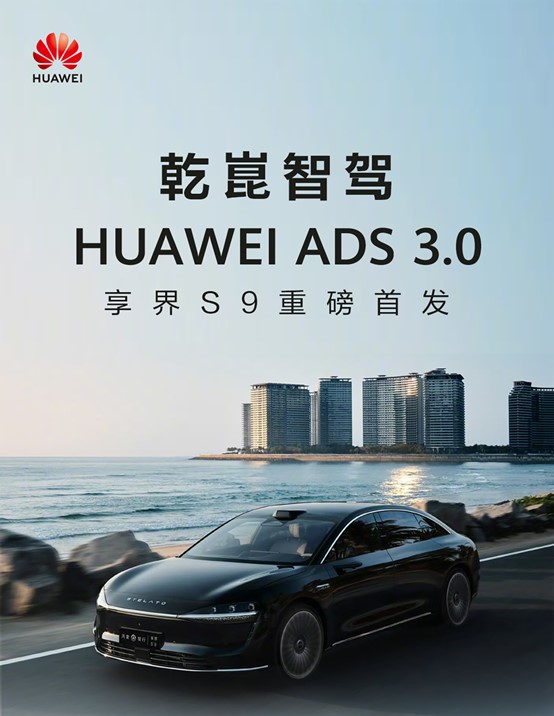On August 6th, Huawei's smart flagship sedan, the STELATO S9, was released in collaboration with BAIC and has officially been delivered. The STELATO S9 is equipped with Huawei's ADS 3.0 intelligent driving system and comes standard with a 100kWh Huawei 800V Giant Whale battery across the series. The STELATO S9 Max is priced at 399,800 yuan, and the STELATO S9 Ultra is priced at 449,800 yuan.
In terms of intelligent driving, the STELATO S9 is the first to be installed with Huawei’s high-end intelligent driving system - Huaiwei ADS 3.0 system, supporting road-adaptive AEB and eAES automatic emergency avoidance functions. It is the first to launch with parking-to-parking intelligent driving experience, supporting parking start, roadside temporary parking, and automatic toll collection.
The entrance models of AITO series cooperated with Seres , equipped with Huawei ADS 2.0 system, will be fully upgraded to Huawei ADS 3.0 in September this year.
The HUAWEI ADS 3.0 advanced intelligent driving system, which was first launched with the STELATO S9, adopts an end-to-end human-like brain to achieve more efficient and safer human-like intelligent driving. It uses cloud-based training of AI deep learning models to achieve rapid iteration every 5 days. The eAES automatic emergency steering system's emergency avoidance function can effectively reduce or avoid collision risks. The road-adaptive AEB system and rearward active safety system can easily handle various complex road conditions and a variety of sudden dangerous road conditions. The ADS 3.0 advanced intelligent driving system has achieved a smooth and safe driving experience by enhancing its perception of road conditions and the driving environment.

In terms of automatic parking, the ADS 3.0 advanced intelligent driving system can achieve parking-to-parking intelligent driving functions, supporting autonomous arrival from parking spaces to public roads, from public roads to park roads, and from park roads to underground parking spaces, and the parking capability has been further increased, achieving full-scene automatic parking for various extremely narrow parking spaces and extremely narrow passages. Moreover, the parking valet service has been officially commercialized, supporting automatic cruise to find parking spaces, and after arriving at the destination, the vehicle parks autonomously, achieving full-scene penetration of parking, allowing the car to "drive and stop by itself," bringing a true end-to-end autonomous driving experience to car owners.

Currently, HUAWEI ADS 3.0 Intelligent Driving Sytem has cooperated with GAC Trumpchi, Voyah Automobile, BAIC Blue Valley Arcfox, Audi, Formula Leopard, Deepal Automobile, and others.
As a high-end model targeting luxury models such as the Mercedes-Benz S450L, BMW 735Li and Audi A8, the document released on the official website of BAIC Blue Valley shows that the cumulative delivery of the STELATO S9 is expected to reach 480,000 units during its five-year life cycle. Specifically, the delivery from 2024 to 2028 will be 60,000, 120,000, 120,000, 96,000, and 84,000 units, respectively. In comparison, Audi A6L sold a total of 180,000 units last year, and the Mercedes-Benz E-Class and BMW 5 Series are around 140,000 units each.
In addition, it is reported that the first model of the MAEXTRO, a cooperation between Huawei and Jianghuai Automobile (JAC), is planned to be launched in the first quarter of next year, and will also be equipped with new high-end configurations including Huawei HIMA (Harmony lntelligent Mobility Alliance) cockpit, aiming at luxury models, positioning against Maybach, with a price as high as the million-yuan level.
Currently, Huawei HIMA has established four major brands: AITO, LUXEED, STELATO, and MAEXTRO, forming a brand matrix, and its market influence is expected to be further strengthened. According to Yu Chengdong, a member of the Huawei Executive Committee, Chairman of the Terminal BG, and Chairman of the Intelligent Automotive Solutions BU, as of this August, the total mileage of Huawei's intelligent driving has reached 460 million kilometers, doubling from 220 million kilometers in May. Huawei's intelligent driving accumulated more than 800 million kilometers of AEB verification in 2023, and the monthly usage of parking is 400,000 times. In the first half of this year, Huawei's vehicle BU has achieved a turnaround from loss to profit. Among them, HIMA delivered nearly 200,000 vehicles in the first half of the year.
Chinese and American car companies are actively promoting the landing of end-to-end intelligent driving models. It is known that since March 16, 2024, Tesla has started to push the latest FSD Beta V12.3 version of the high-end assisted driving system to all FSD order and subscription users in the United States, which means that the commercial landing of the end-to-end intelligent driving model represented by FSD V12 is imminent. Volkswagen is also cooperating with Rivian to develop intelligent driving systems for the American market.
Compared with Tesla's FSD, which insists on pure vision, Huawei's intelligent driving system adopts a fusion perception scheme, combining LiDAR, millimeter-wave radar, cameras, etc., to achieve the goal of autonomous driving by integrating various sensors.









